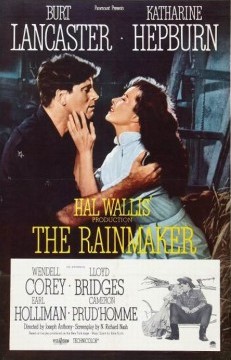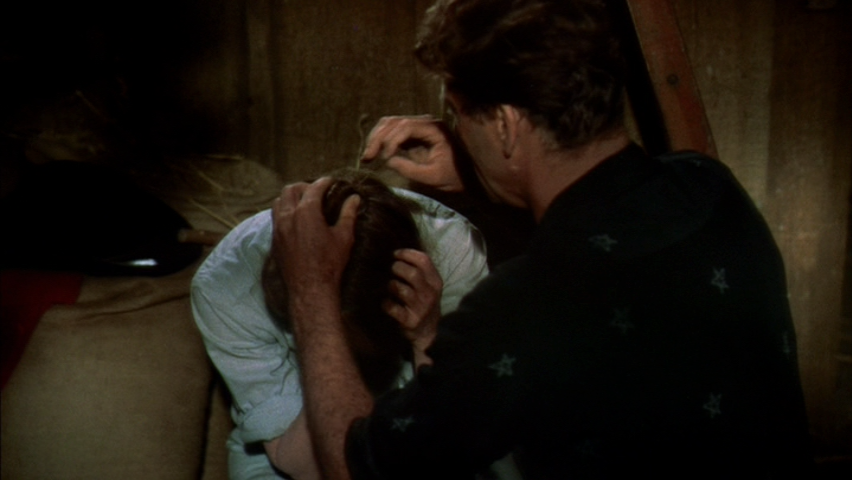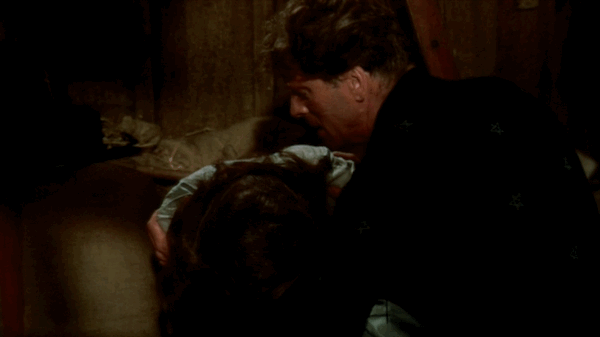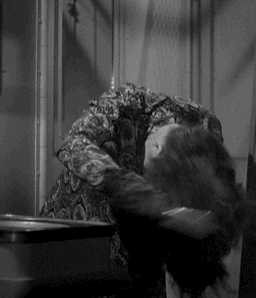Episode 31 of 52: In which Katharine Hepburn lets her hair down and rolls in the hay with Burt Lancaster.
 It makes a certain kind of sense that The Rainmaker, which is the last of Kate’s Spinster Films, should be the most archetypal of this phase of her career. N. Richard Nash’s screenplay about a silver-tongued conman (Burt Lancaster) who promises water to a town and love to an old maid (Kate) works almost as a genre checklist: Lonely Single Woman? Check. Scenes establishing that most folks find her plain? Check. Handsome outsider who sees the beauty in her? Check. Life affirming rendezvous? Check. Throw in a metaphor about the drought-stricken land and Lizzie’s lovelorn heart, and you have The Rainmaker.
It makes a certain kind of sense that The Rainmaker, which is the last of Kate’s Spinster Films, should be the most archetypal of this phase of her career. N. Richard Nash’s screenplay about a silver-tongued conman (Burt Lancaster) who promises water to a town and love to an old maid (Kate) works almost as a genre checklist: Lonely Single Woman? Check. Scenes establishing that most folks find her plain? Check. Handsome outsider who sees the beauty in her? Check. Life affirming rendezvous? Check. Throw in a metaphor about the drought-stricken land and Lizzie’s lovelorn heart, and you have The Rainmaker.
Make no mistake, Lancaster and Hepburn elevate The Rainmaker. Their acting styles clash--Kate’s Old Hollywood manner butts against Lancaster’s charismatic, physical style (which he’d later hone for the incredible Elmer Gantry). Apparently, the two actors disagreed on the set as well. As a result, though both are compelling, they’re never connected in their scenes together. This works in the film’s favor. It’s completely believable that Starbuck and Lizzie are two people who can love each other for a night, but don’t like each other enough to truly fall in love for good. Their dreams are too different; they don't see each other for who they really are.
The best thing about having a film as unsubtle as The Rainmaker is that it relies heavily on its stars, both in acting talent and in star image. Much of this series has been devoted to identifying, attempting to dissect, and--as often as not--flat out worshipping Katharine Hepburn’s star qualities. We’ve touched on everything from Kate’s beauty to her tomboyishness to her charisma and comedic chops, but we’ve neglected one physical trait which was as defining to later Kate as her famous cheekbones: her hair. More specifically, this is about Katharine Hepburn’s hairography, in the key scenes where she unwound the topknot and let it all hang loose.
My official Katharine Hepburn Hair Theory after the jump

Kate’s rather severe bun makes early appearances in movies like Song of Love and Without Love, but it isn’t until The African Queen that the tight topknot established itself as a permanent fixture of Kate’s onscreen style. In The African Queen, the more clothes (and hairpins) Rosie loses, the more human she becomes, until she fully transforms from uptight minister’s sister to the kind of heroine who can argue with Nazis and smile at her own wedding/hanging. Later, in Summertime, the thematic link between Kate’s hairdo and her heart is more definitely (and romantically) established, since Jane Hudson only lets her hair down once, to swap sunset kisses with her lover de Rossi.
The Rainmaker more obviously uses Kate’s hair for effect. The turning point of the film--and Lizzie's self image--is the love scene in the barn. In an effort to convince the heartbroken Lizzie that she is beautiful, Starbuck unpins her hair. As it cascades down, she hides behind it, even as Starbuck cajoles her to say “I’m pretty.” Lizzie cries and hides and refuses, until she suddenly gains brief courage, and yells it out.

Close your eyes. Close them. Now say, "I'm pretty." Say it, Lizzie! Say it!

The scene progresses from there as you’d expect.
It’s cheesy as a 90s romcom, but Lancaster and Hepburn save the scene from falling into cliche. Kate shows such shocking transformation and vulnerability in the moment, and when she claims herself she lights up in a way that's been dampened since the beginning of the film. This is the signifier Kate’s hair will become in the future. It’s not about heroism or sex, it’s about the vulnerability of letting go of control ever so briefly. For Lizzie, it’s letting go of what she knows and trusting what Starbuck believes. For later characters, it will be a descent into madness or a contemplative moment of grieving.
When Katharine Hepburn took her hair down from its iconic bun, she turned it into a prop and a thematic device. It could be a shield, a pillow, a curtain, a frame, something to be gathered or pulled or mangled or smoothed depending on her character’s emotion. In our upcoming movies, watch for the scenes where Kate lets her hair down. They’re some of the most powerful she put to film.
Can you think of another actor or actress who did the same? I’m pulling my own hair out trying to think of one. Post in the comments below!

 Previous Week: The Iron Petticoat (1956) - In which you’d think Katharine Hepburn would have learned to stay away from accents by now.
Previous Week: The Iron Petticoat (1956) - In which you’d think Katharine Hepburn would have learned to stay away from accents by now.
Next Week: Desk Set (1957) - In which Katharine Hepburn plays a woman named Bunny who starts a battle of wits with Spencer Tracy's computer. That's actually the plot.
Tuesday 8/12: Hit Me With Your Best Shot crossover -Suddenly, Last Summer
* This is actually a gif from Without Love, but I saved it until now. I think it fits better here.